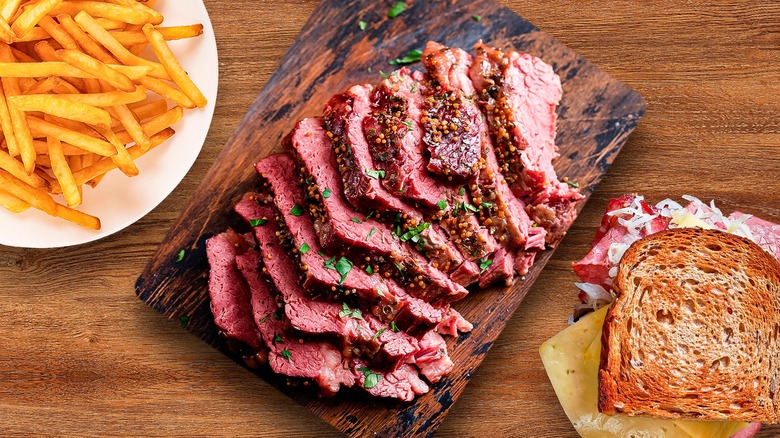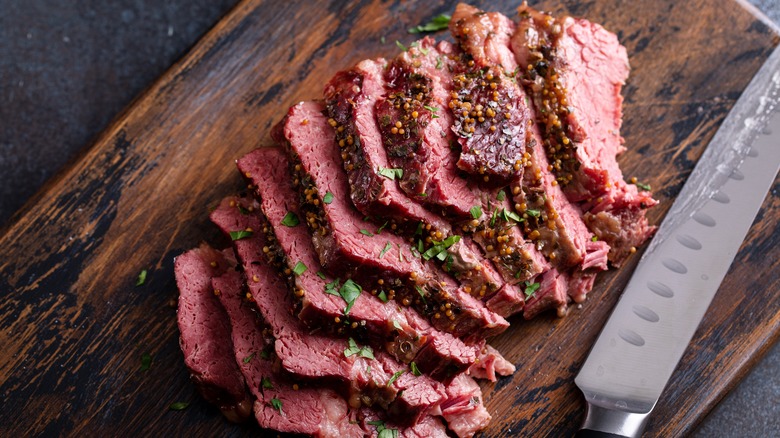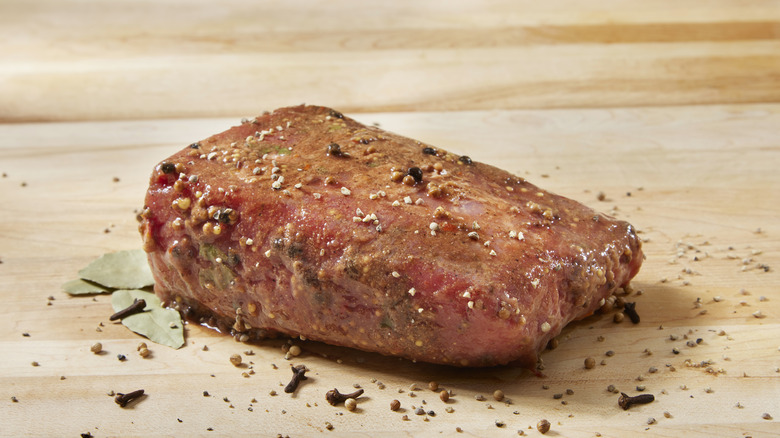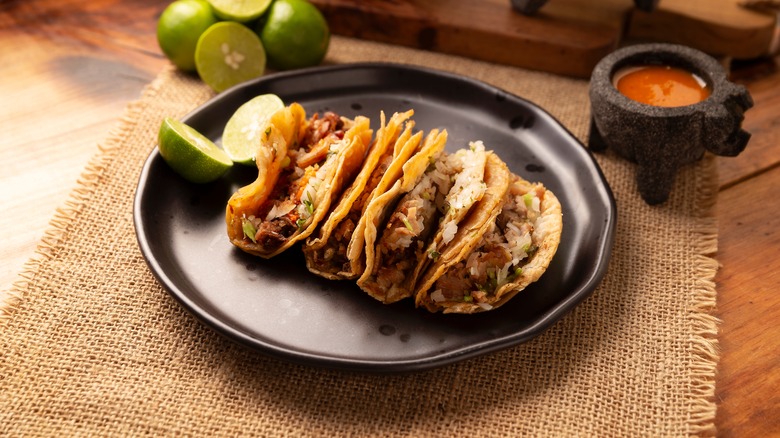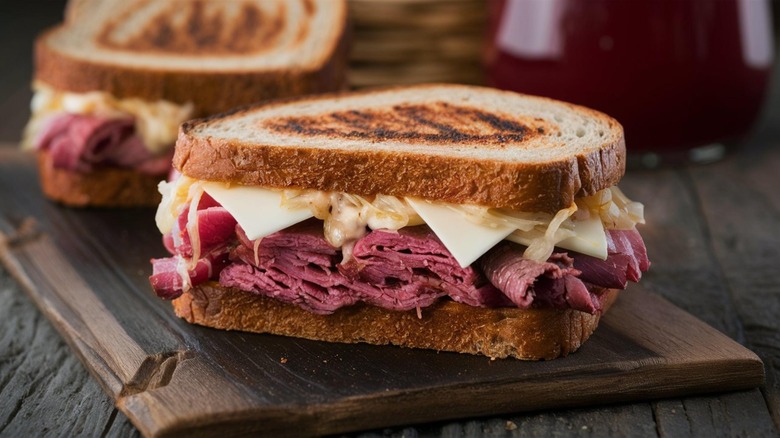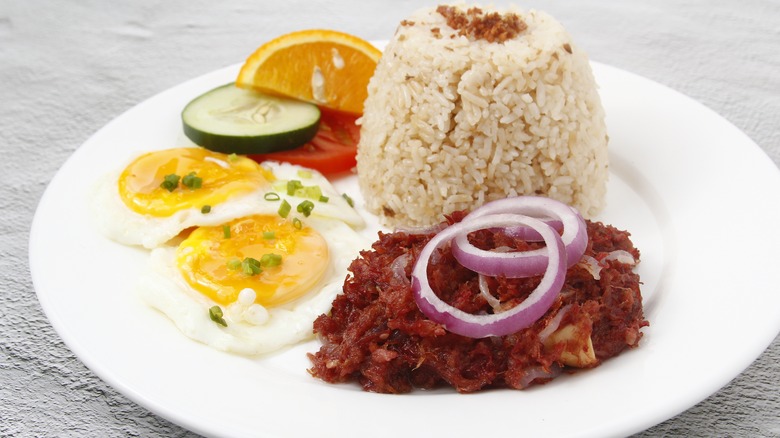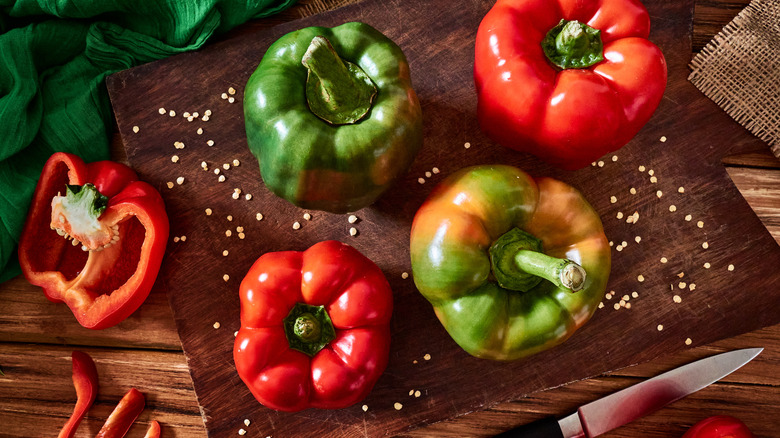11 Ways To Upgrade Corned Beef
Corned beef is part of numerous cuisines around the world, including Irish, Ashkenazi Jewish, English, and Filipino. In many ways, however, this delicious cured meat is misunderstood. For one thing, there's its name. Corned beef doesn't have anything to do with corn; instead, the "corn" refers to the large, nearly corn kernel-sized pieces of kosher salt that are used in the brining process. That said, the corned beef many people are familiar with may not be served as warm slices, but rather from a can. Popularized worldwide over the course of the 19th and 20th centuries by the British and Americans, canned corned beef has become a staple in kitchens around the world, and it's a key ingredient in a number of now-traditional recipes.
However you like your corned beef, it's hard to argue that it's a savory treat that elevates any dish. Believe it or not, you can make your corned beef and favorite corned beef meals even better. Here are some ways to upgrade your corned beef, with tips from experts Jake Dell, owner of Katz's Deli; Sarri Harper, third generation owner of Carnegie Deli; Nic Vanderbeeken, chef at Apéritif Bali and a corned beef expert; and Greg Dixon, Vice President of Roberts Corned Meats, Inc., a San Francisco company that specializes in corned beef and has been in business for more than a century.
Choose fresh over canned
Some recipes or even entire cuisines traditionally call for canned corned beef, but in most cases, our experts believe it's best to go with fresh corned beef. Carnegie Deli owner Sarri Harper tells us, "While the two may have similar flavor profiles, canned corned beef is mushier, saltier, and fattier than fresh corned beef." Chef and corned beef expert Nic Vanderbeeken adds, "While canned corned beef can be convenient, it often lacks the depth of flavor and the tenderness that comes from making it from scratch. Freshly made corned beef allows you to control the flavor profile and the texture, which is crucial for creating a truly satisfying dish."
There are generally three forms of fresh corned beef. One is pre-cured, pre-cooked slices. The second form is a pre-cured cut of meat that you have to cook at home, usually by boiling it for a few hours (although you can also cook corned beef in a slow cooker, oven, or even a pan). The third and most hands-on form of fresh corned beef is purchasing a raw cut of beef (usually brisket) that you can brine and cook yourself. You should be able to buy one or more of these forms of fresh corned beef at your local deli or supermarket. Some companies, including Carnegie Deli and Katz's Deli, even sell corned beef online that can be shipped anywhere in the U.S. (as well as Canada, for Katz's).
Be creative with brine but choose the right cut of meat
If you choose to make your own corned beef, it may seem daunting, but you don't have to be intimidated. While you will need kosher salt and pink curing salt (unless you're going nitrate-free), there's a lot of leeway when it comes to the seasonings you can use in your brine. Corned beef's saltiness is usually set off with something sweet. Many cooks, including corned beef expert Nic Vanderbeeken and Greg Dixon of Roberts Corned Meats, recommend adding brown sugar to the brine. Other popular choices include seasonings like peppercorns and garlic. You can experiment and change things up, making your corned beef align perfectly with your taste preferences.
For the best results, the cut of beef that you choose is a major factor. Technically, you can use any cut of beef, but brisket is considered the best cut of meat to use for corned beef. Many chefs prefer the part of the brisket called the flat cut, but Dixon recommends buying the entire brisket (packer brisket), since one end, the point end, will have more flavorful fat content and the other, the flat end, will be leaner and easier to cut. Dixon calls packer brisket "the best of both worlds". Whatever cut you choose, avoid meat that's too lean, since fat adds flavor and moisture that's crucial to making delicious corned beef.
Take your time when brining and boiling
Whether you're cooking a piece of store-bought brined corned beef or one you've brined yourself, you'll often come across the phrase "low and slow" — that is, low cooking temperature and keeping in mind that it's important not to rush things. As Sarri Harper says, "Patience is key when making corned beef." As a general rule, most cooks will suggest soaking it in brine for at least five days, but Nic Vanderbeeken kicks that number up to "at least seven to 10 days".
Greg Dixon warns that even if they've successfully brined their meat or they're starting the cooking process with corned beef that was already brined, the thing that trips many people up is overcooking their corned beef. The most common way to cook corned beef is by boiling it, but boiling, Dixon warns, actually means keeping the water at "a simmer or a low boil at the most". He advises cooks that this process can take about three to four hours, but to keep an eye on your pot to make sure the water isn't getting any hotter.
Replace a typical ingredient with corned beef
Are the meals you usually make feeling a little stale? The next time you make one of your go-to recipes, why not add some corned beef or use corned beef as a replacement for an ingredient? Corned beef's richer, saltier flavor will liven up meals you've gotten used to — and combining it with the other ingredients might just bring out corned beef's flavor, as well. It's a win-win, taking both a typical meal and corned beef to the next level.
You can add corned beef to just about any savory classic. For instance, why not sprinkle a few small pieces of corned beef onto loaded baked potatoes, alongside your usual favorite fillings? You can add diced corned beef to your potato salad instead of ham. The powerful, flavorful punch of this add-in will make for an unforgettable take on an iconic side dish. "I recently started making roasted Brussels sprouts with corned beef instead of bacon, and it's quickly become a favorite," Sarri Harper said. "It can be used in place of pulled pork or carne asada in tacos or burritos, as a protein substitute for fried rice in Asian dishes or casseroles at home," said Greg Dixon. "It is also a great alternative for a Sunday roast or Holiday roast in place of hams, turkey, or prime rib."
Make a classic Reuben
A deli favorite, the classic Reuben is a hot sandwich featuring corned beef, Thousand Island dressing, sauerkraut, and melted Swiss cheese on toasted rye bread. This ingenious taste and texture combination actually has two potential origins. The descendants of Bernard Schimmel, a chef working at his family's hotel in Nebraska, claim he came up with the sandwich one night in the 1920s. In this version, the sandwich is named in honor of the friend Schimmel cooked it up for, Reuben Kulakofsky. This has been debated, however, notably by food historian Andrew Smith — he believes it was first created in New York City, citing an early 20th century cookbook, among other evidence.
Whatever the truth really is, the Reuben continues to be a popular corned beef dish. Jake Dell tells us that the best-selling sandwich at Katz's Deli is the Reuben, and it's no wonder. "A traditional corned beef Reuben always puts me in a good mood," said Sarri Harper. If you've never made a Reuben, why not give it a try? If the sandwich's popularity is anything to go by, it just may be the best way to eat corned beef.
Pair corned beef with fries
There's a reason many of us associate corned beef with potatoes — the cured meat's texture and salty, flavorful taste pairs well with potatoes' starchy goodness. However, that doesn't just mean boiled or sautéed potatoes. Some corned beef aficionados prefer another version of spuds: French fries. "For me nothing is better with Corned Beef than our steak fries," says Jake Dell of Katz's Deli. "Our steak fries are nice and crispy, with a little buttery flavor that makes them the perfect compliment to the salty and tender corned beef."
Of course, if you prefer a different French fry cut, there's nothing holding you back from using that kind instead. For instance, waffle fries might provide an interesting taste ratio to your slices of corned beef. If you really want to change up the flavor of your corned beef dish, sweet potato fries could be worth a try. The pairing of sweet and salty might bring an unique and unexpected flavor to your dish.
Put it on a burger
Although it's a sandwich filling (and sandwich star) in its own right, corned beef's tender texture and rich, salty flavor also make it a perfect burger topping. In fact, corned beef may just be the burger topping most of us have been missing all along. It's the next step up from bacon, providing that same delicious salty kick but with a thicker texture and richer, more unique taste due to its variety of potential brine ingredients. No wonder Jake Dell says that some Katz's Deli staff members "swear by putting [corned beef] on top of their cheeseburgers".
Top off your corned beef-adorned burger with your favorite veggies and other fillings, and then finish it off with your sauce of choice. If you're looking for some sauce-related inspiration, both Dell and Sarri Harper's go-to corned beef condiment is mustard. Dell calls it "the perfect compliment to the savory salty super tender beef." His mustard of choice is Katz's house deli mustard, which has deep tanginess, making it "the perfect compliment to the savory salty super tender beef." For Harper, Düsseldorf mustard can't be beat. "It's a stone ground mustard that's both creamy and bold, and cuts through the richness of the corned beef," she explains. Greg Dixon, meanwhile, recommends his dad's favorite, sweet hot mustard "a mix of mustard, brown sugar and horseradish."
Serve it with a potato knish
Corned beef's origins lie in Ireland, but the Eastern European Jewish community has also contributed to the meat's success, popularity, and flavor. In fact, while corned beef has Irish roots, for the Irish who immigrated to America in the 19th and early 20th centuries, it was a new discovery. Many had never tasted corned beef until they arrived in the Lower East Side of Manhattan and started to buy this affordable meat that was made and sold in the neighborhood's Jewish delis.
While corned beef is often paired with boiled or sautéed potatoes, Sarri Harper has a more unusual potato side she likes to eat with her corned beef: a potato knish. A knish is a fried snack of seasoned mashed potatoes (and sometimes other ingredients) wrapped in pastry dough. It originated in Eastern Europe and was brought to the United States by Jewish immigrants in the early 20th century. For Harper, this iconic Ashkenazi Jewish treat and New York City favorite makes for a perfect pairing with corned beef. "Both comforting and delicious, the smooth texture and mild flavor of the knish really allows the corned beef to be the star of the show," she raves. The meal is also, incidentally, a pairing of two cultures that have made corned beef what it is today.
Consider going nitrate-free
Most traditional corned beef recipes use nitrates as a key ingredient since they help preserve the meat. While nitrates definitely do the job as a preservative, they've also been linked to health problems including colorectal (bowel) and stomach cancers when used this way. Now and then, it may be okay for most of us to indulge in the most common kind of corned beef — sometimes called "red corned beef" due to the color it gets from the nitrate-containing pink curing salt in its brine. However, there is a healthier alternative called gray corned beef that is made without nitrate, and thus doesn't have that typical red color.
Gray corned beef may sound like a newfangled health fad, but it's actually the kind traditionally made in New England. It may seem like this healthier, tried and true corned beef is the way to go, but there are some downsides. For one thing, gray corned beef has a higher salt content, since salt is the only thing being used to preserve the meat. This also makes it taste saltier than red corned beef. Another downside is that, depending on where you live, gray corned beef may not be easy to find, so you may have to make it yourself. If nitrate-free meals are a priority for you, gray corned beef is an excellent option.
Make a Filipino corned beef dish
Corned beef dishes are popular in the Philippines, and it's no wonder: they're tasty and delicious. While it's frowned upon as a general cooking rule, most Filipino corned beef dishes use the canned version of the meat. A lot of this is due to history. Canned beef was popularized in the Philippines during the American occupation (1898-1946) and it's become a common ingredient in Filipino cuisine.
There are several Filipino corned beef dishes you can make, but our favorite is corned beef silog (sometimes called cornsilog) — sautéed canned corned beef, onions, garlic fried rice, and a fried egg. The onions are usually mixed into the corned beef, while the egg and rice are served alongside it, but you can mix everything together in your dish for a maximum flavor experience. If there's an ingredient you'd like to add or substitute, get creative! Another popular, delicious Filipino corned beef dish is ginisang corned beef. Similar to corned beef hash, it consists of canned corned beef (the chunky kind, if possible) and potatoes sautéed together. Again, you can add any other ingredients or seasonings that might catch your fancy. For both of these recipes, the most important rule is to use the highest quality brand of canned corned beef you can find for the best taste and texture.
Combine corned beef and your favorite foods
For many of us, corned beef is a comfort food that often evokes strong feelings of nostalgia. You may have grown up with a particular corned beef dish such as the Reuban. For metro New Yorkers like myself, it could very well be a high-stacked corned beef sandwich on rye with a pickle on the side. Others have a special place in their heart for classics like corned beef hash or corned beef and cabbage. As dear to our hearts as these dishes are, remember that corned beef doesn't stop there. You can use it in a myriad of different ways, and it can be a great substitute in other dishes.
For instance, Nic Vanderbeeken has created an upgraded version of traditional corned beef hash that adds some new flavors. "I combine the beef with diced potatoes, onions, and bell peppers, finishing it off with a sunny-side-up egg," he says. "This dish is comforting and highlights the corned beef beautifully." Sarri Harper has some additional suggestions, including a corned beef and cabbage quiche that she likes to eat for breakfast. If you want to take your corned beef to the next level, don't just consider tradition — try to create new corned beef meals that include other foods and flavors you love. The sky is the limit when it comes to this delicious take on meat.
